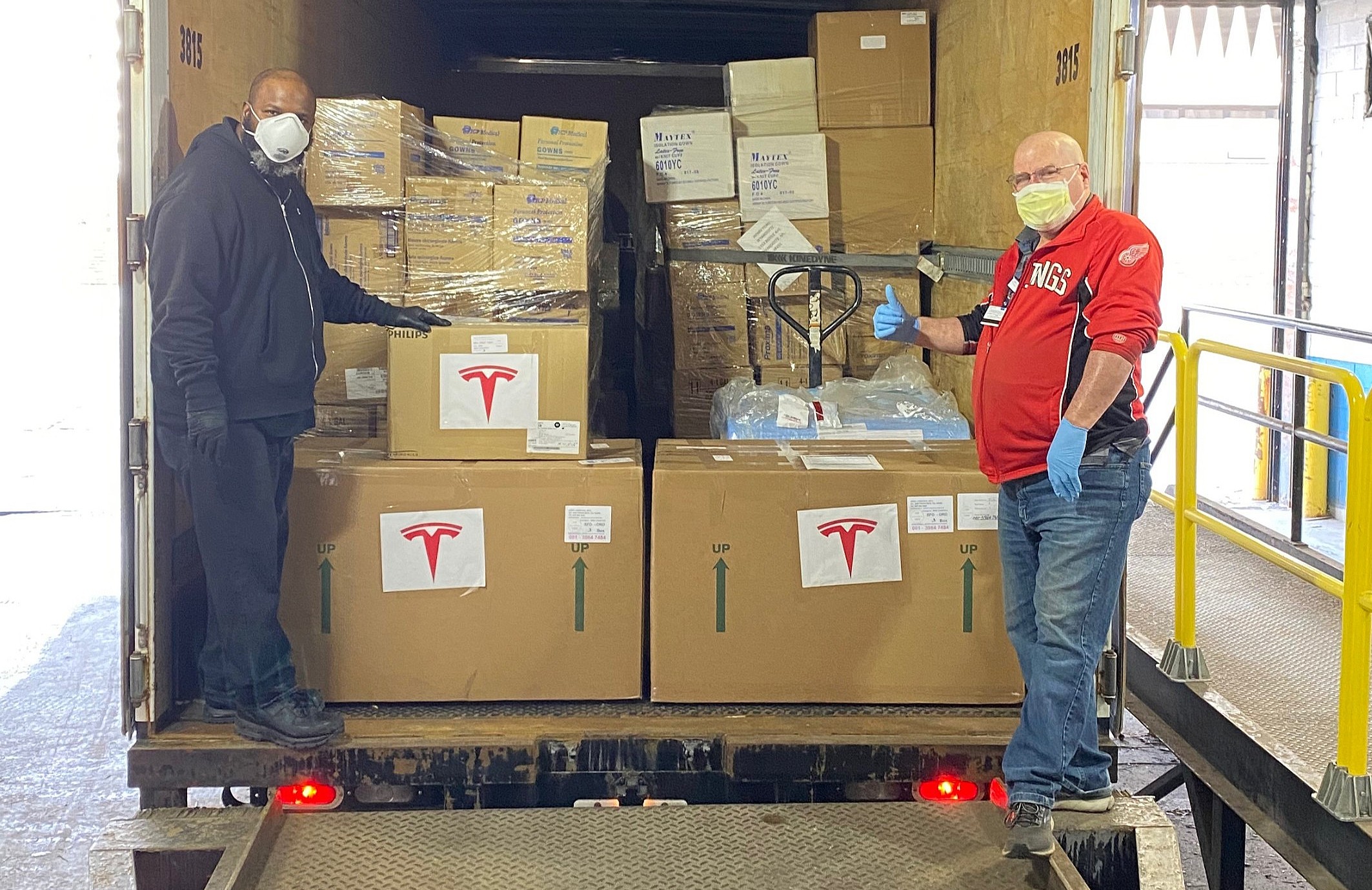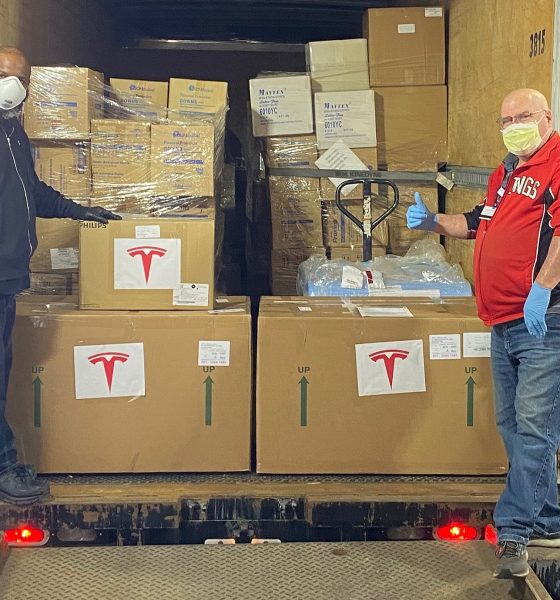

News
Tesla’s non-invasive ventilator donations are becoming invaluable in battle against virus
Tesla CEO Elon Musk recently revealed the rationale behind his efforts at providing numerous non-invasive ventilators to hospitals. The recommendation, which suggested the use of of CPAP and BiPAP ventilators, came from doctors in Wuhan, China, the epicenter of the COVID-19 pandemic.
Musk was tagged in a tweet from a follower who cited findings which concluded that invasive ventilators should not be used immediately for treatment of COVID-19 patients. StatNews reported that oxygen is the first option, and if it proves to be ineffective, CPAP or BiPAP machines are the next recommended step.
The follower ended their tweet by clarifying what the CPAP and BiPAP were, stating, “You know the ones that @elonmusk gave out, and got attacked for doing so.”
“We use CPAP a lot, and it works well, especially in combination with having patients lie prone,” Schultz said.
— Supernova Style Science News (@Supernova_Style) April 22, 2020
Musk then cited his conversation with physicians in Wuhan. “When I talked to doctors in Wuhan, they recommended against invasive ventilators & in favor of non-invasive,” he replied. “Numbers I was told from Wuhan were 80% to 90% mortality rate for invasive ventilators. Those are not good odds.”
Musk’s machines have captured the attention of both supporters and critics of the Tesla CEO. His supporters his generosity, while his critics picked apart his donations, stating the machines were useless and a publicity stunt for some free PR.
When I talked to doctors in Wuhan, they recommended against invasive ventilators & in favor of non-invasive
— Elon Musk (@elonmusk) April 22, 2020
However, Musk’s donations were not a ploy for attention, nor were they the wrong machines. As it turned out, his contributions had to do with a conversation with doctors who were working in the heart of the pandemic, who recommended smaller and less invasive ventilators for patients.
In addition to the Wuhan doctors stating that less-invasive options were proving to be more beneficial, Musk and Tesla were also in close communication with each of the more than 50 hospitals that received the non-invasive machines. This step ensured that the hospitals receiving ventilators knew exactly what they were getting, and they were not at all caught off guard by the non-invasive nature of the machines.
Numbers I was told from Wuhan were 80% to 90% mortality rate for invasive ventilators. Those are not good odds.
— Elon Musk (@elonmusk) April 22, 2020
Musk has taken steps to help assist the fight against the coronavirus. After purchasing 1,200 ventilators from China and donating them directly to the City of Los Angeles, Musk made it clear that Tesla would be willing to give additional machines to hospitals in need. The company is offering worldwide shipping of ventilators to hospitals in need within its delivery areas. So far, hospitals across the United States and even some from abroad have received donations.
Tesla has also managed to begin developing in-house ventilators, which are built with the company’s car parts.

News
Tesla FSD fleet is nearing 7 billion total miles, including 2.5 billion city miles
As can be seen on Tesla’s official FSD webpage, vehicles equipped with the system have now navigated over 6.99 billion miles.

Tesla’s Full Self-Driving (Supervised) fleet is closing in on almost 7 billion total miles driven, as per data posted by the company on its official FSD webpage.
These figures hint at the massive scale of data fueling Tesla’s rapid FSD improvements, which have been quite notable as of late.
FSD mileage milestones
As can be seen on Tesla’s official FSD webpage, vehicles equipped with the system have now navigated over 6.99 billion miles. Tesla owner and avid FSD tester Whole Mars Catalog also shared a screenshot indicating that from the nearly 7 billion miles traveled by the FSD fleet, more than 2.5 billion miles were driven inside cities.
City miles are particularly valuable for complex urban scenarios like unprotected turns, pedestrian interactions, and traffic lights. This is also the difference-maker for FSD, as only complex solutions, such as Waymo’s self-driving taxis, operate similarly on inner-city streets. And even then, incidents such as the San Francisco blackouts have proven challenging for sensor-rich vehicles like Waymos.
Tesla’s data edge
Tesla has a number of advantages in the autonomous vehicle sector, one of which is the size of its fleet and the number of vehicles training FSD on real-world roads. Tesla’s nearly 7 billion FSD miles then allow the company to roll out updates that make its vehicles behave like they are being driven by experienced drivers, even if they are operating on their own.
So notable are Tesla’s improvements to FSD that NVIDIA Director of Robotics Jim Fan, after experiencing FSD v14, noted that the system is the first AI that passes what he described as a “Physical Turing Test.”
“Despite knowing exactly how robot learning works, I still find it magical watching the steering wheel turn by itself. First it feels surreal, next it becomes routine. Then, like the smartphone, taking it away actively hurts. This is how humanity gets rewired and glued to god-like technologies,” Fan wrote in a post on X.
News
Tesla starts showing how FSD will change lives in Europe
Local officials tested the system on narrow country roads and were impressed by FSD’s smooth, human-like driving, with some calling the service a game-changer for everyday life in areas that are far from urban centers.

Tesla has launched Europe’s first public shuttle service using Full Self-Driving (Supervised) in the rural Eifelkreis Bitburg-Prüm region of Germany, demonstrating how the technology can restore independence and mobility for people who struggle with limited transport options.
Local officials tested the system on narrow country roads and were impressed by FSD’s smooth, human-like driving, with some calling the service a game-changer for everyday life in areas that are far from urban centers.
Officials see real impact on rural residents
Arzfeld Mayor Johannes Kuhl and District Administrator Andreas Kruppert personally tested the Tesla shuttle service. This allowed them to see just how well FSD navigated winding lanes and rural roads confidently. Kruppert said, “Autonomous driving sounds like science fiction to many, but we simply see here that it works totally well in rural regions too.” Kuhl, for his part, also noted that FSD “feels like a very experienced driver.”
The pilot complements the area’s “Citizen Bus” program, which provides on-demand rides for elderly residents who can no longer drive themselves. Tesla Europe shared a video of a demonstration of the service, highlighting how FSD gives people their freedom back, even in places where public transport is not as prevalent.
What the Ministry for Economic Affairs and Transport says
Rhineland-Palatinate’s Minister Daniela Schmitt supported the project, praising the collaboration that made this “first of its kind in Europe” possible. As per the ministry, the rural rollout for the service shows FSD’s potential beyond major cities, and it delivers tangible benefits like grocery runs, doctor visits, and social connections for isolated residents.
“Reliable and flexible mobility is especially vital in rural areas. With the launch of a shuttle service using self-driving vehicles (FSD supervised) by Tesla in the Eifelkreis Bitburg-Prüm, an innovative pilot project is now getting underway that complements local community bus services. It is the first project of its kind in Europe.
“The result is a real gain for rural mobility: greater accessibility, more flexibility and tangible benefits for everyday life. A strong signal for innovation, cooperation and future-oriented mobility beyond urban centers,” the ministry wrote in a LinkedIn post.
News
Tesla China quietly posts Robotaxi-related job listing
Tesla China is currently seeking a Low Voltage Electrical Engineer to work on circuit board design for the company’s autonomous vehicles.

Tesla has posted a new job listing in Shanghai explicitly tied to its Robotaxi program, fueling speculation that the company is preparing to launch its dedicated autonomous ride-hailing service in China.
As noted in the listing, Tesla China is currently seeking a Low Voltage Electrical Engineer to work on circuit board design for the company’s autonomous vehicles.
Robotaxi-specific role
The listing, which was shared on social media platform X by industry watcher @tslaming, suggested that Tesla China is looking to fill the role urgently. The job listing itself specifically mentions that the person hired for the role will be working on the Low Voltage Hardware team, which would design the circuit boards that would serve as the nervous system of the Robotaxi.
Key tasks for the role, as indicated in the job listing, include collaboration with PCB layout, firmware, mechanical, program management, and validation teams, among other responsibilities. The role is based in Shanghai.
China Robotaxi launch
China represents a massive potential market for robotaxis, with its dense urban centers and supportive policies in select cities. Tesla has limited permission to roll out FSD in the country, though despite this, its vehicles have been hailed as among the best in the market when it comes to autonomous features. So far, at least, it appears that China supports Tesla’s FSD and Robotaxi rollout.
This was hinted at in November, when Tesla brought the Cybercab to the 8th China International Import Expo (CIIE) in Shanghai, marking the first time that the autonomous two-seater was brought to the Asia-Pacific region. The vehicle, despite not having a release date in China, received a significant amount of interest among the event’s attendees.








